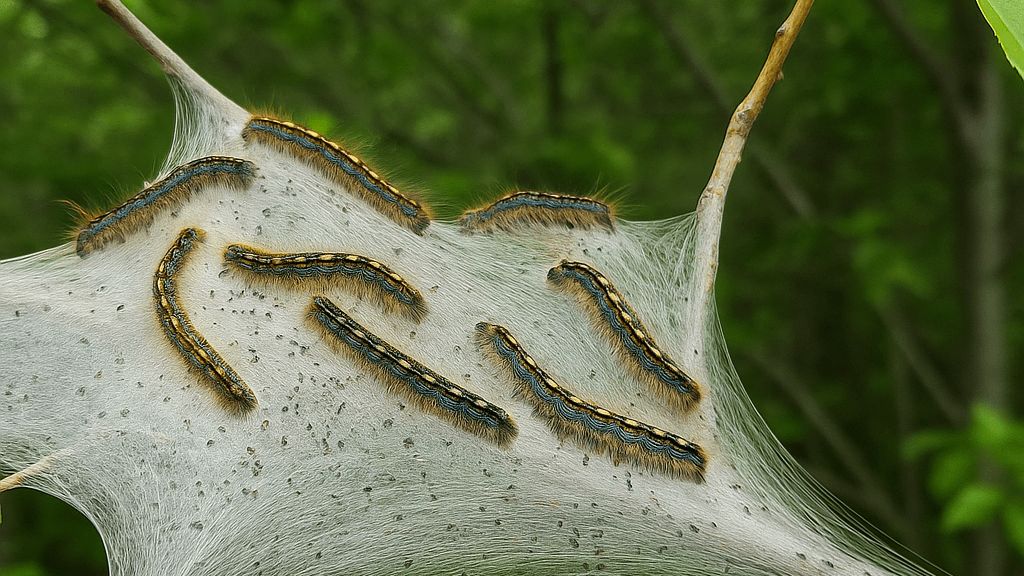Forests across Ontario are experiencing a noticeable increase in tent caterpillar activity this year, marking what experts describe as an outbreak season for the species. While these events can draw attention from campers, hikers, and homeowners, they are part of a natural cycle that has occurred for generations.
Recognizing the Tent Caterpillar
The tent caterpillar is a distinctive insect that many people notice in late spring and early summer. Its appearance includes a hairy body, blue and black patterns, and a line of pale, keyhole-shaped spots running along its back. Despite its name, it is not always found in tent-shaped silk structures, though these are often seen on branches where the insects feed and take shelter.
These caterpillars are sometimes mistaken for the larvae of the spongy moth due to their similar body shapes and coloring. However, tent caterpillars have their own unique life cycle and feeding preferences.
Life Cycle and Timing
Tent caterpillars follow a predictable seasonal pattern. Eggs are typically laid in late June or early July, wrapped around twigs in a shiny, black casing that protects them through the winter. When spring arrives, the larvae hatch and begin feeding on the leaves of hardwood trees.
By mid-June, the caterpillars spin cocoons, from which adult moths emerge later in the summer. These moths are usually drawn to lights at night, making them more noticeable around homes and campsites.
Feeding Habits and Preferred Trees
Tent caterpillars have a wide range of hardwood hosts, but they show a preference for certain species. Common choices include:
- Cherry trees – a primary food source
- Apple trees – often targeted in orchards and yards
- Serviceberry – a favored option in mixed woodlands
- Aspen and poplar – abundant in Ontario forests
While heavy infestations can result in complete defoliation of trees, most healthy hardwoods are able to recover, especially if they are not defoliated in consecutive years. Young or stressed trees, however, may experience more lasting effects.
Understanding Outbreak Cycles
Ontario typically experiences tent caterpillar outbreaks every 10 to 12 years, with each outbreak lasting three to six years in the same area. The intensity of the current increase in population varies by location, and while it is noticeable, it is not as severe as some past events.
These population surges are influenced by a combination of environmental conditions, natural predators, and food availability. Eventually, outbreaks decline as natural controls—such as weather changes, parasitic insects, and disease—reduce caterpillar numbers.
Impact on Forests and Communities
For outdoor enthusiasts, the presence of large numbers of tent caterpillars can be an unwelcome surprise. The insects may be seen moving across trails, hanging from branches, or gathering on structures near wooded areas.
In forests, their feeding activity can temporarily reduce the tree canopy, which in turn limits photosynthesis. However, for most mature, healthy trees, this is a short-term setback. New leaves usually emerge later in the summer, restoring much of the lost growth.
What to Expect This Summer
As the season progresses, residents and visitors in Ontario can expect to see more tent caterpillars in early summer, especially in areas with a high concentration of their preferred tree species. By mid-summer, the larvae will transition into cocoons and later emerge as moths, signaling the end of the active feeding phase.
While their numbers can be alarming, these outbreaks are a natural part of forest ecology. They play a role in thinning tree canopies, which allows more light to reach the forest floor and encourages the growth of understory plants.
Coexisting with Tent Caterpillars
For most homeowners and campers, tent caterpillars pose little direct threat. They do not bite, sting, or carry diseases harmful to humans. Their primary impact is on the trees they feed on and the temporary aesthetic change in affected areas.
For those wishing to protect ornamental or young trees, physical removal of egg masses in winter or caterpillars in spring can help reduce local populations. However, in most cases, allowing the natural cycle to run its course is the most effective long-term approach.
As Ontario moves through another tent caterpillar season, residents can take the opportunity to observe these insects as part of the intricate balance of forest life—reminding us that even the smallest creatures have a role in shaping the natural landscape.
Check out a related article about European moths wreaking havoc in the same region here.
